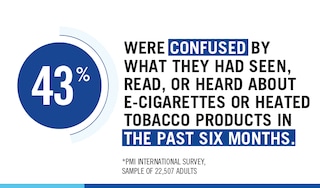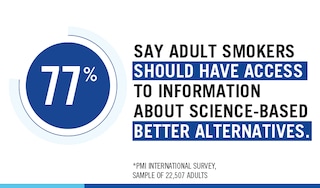We often default to thinking of misinformation and disinformation as phenomena that thrive mainly in the online world, with fake news and conspiracy theories occasionally spilling over into real life. By viewing these primarily as “digital” threats, however, I fear that we sometimes overlook their broader, real-world consequences.
Misleading or false information, whether online or offline, has a very real impact on people’s perceptions and behaviors. At best, it leaves the public confused. At worst, it erodes their trust in facts, science, and expert guidance, and can lead them to make unwise choices.
This confusion and distrust toward evidence and facts is also prominent today in discussions concerning the role that smoke-free alternatives can play, along with existing regulations, in addressing the issue of smoking.
As a scientist working for Philip Morris International, I experience this firsthand. Science and technology have enabled us to develop smoke-free products that—while not risk-free—are a better choice than cigarettes for men and women who would otherwise continue to smoke. At PMI, we have made the bold decision to focus our resources on these products, with the ambition of completely replacing cigarettes as soon as possible.
Can misinformation lead to missed opportunities?
A substantial body of scientific evidence shows that smoke-free products can be a much better choice for adult smokers than continuing to smoke; however, misinformation about these products continues to abound. Often, misleading headlines about poorly executed studies—that focus only on potential downsides—spread inaccuracies at light speed, creating confusion and doubt. The result? Smokers are denied accurate information, severely restricting their ability to learn about these products and how they differ from cigarettes.
This is a missed opportunity for public health. A new international survey commissioned by PMI and conducted by research firm Povaddo revealed that approximately eight in 10 adult smokers (76 percent) would be more likely to consider switching to alternative products like e-cigarettes and heated tobacco products if they had clarity on how these products differ from cigarettes and the science that supports them. Yet almost half of the smokers (43 percent) among those who have seen, read, or heard something about these products in the past six months say they have received conflicting or unclear information.
We all agree the best choice for people who smoke is to quit cigarettes and nicotine altogether. But for those adults who would otherwise continue to smoke, it’s crucial to ensure that at the very least they can get reliable, science-based information about the better choices they can make for themselves. Not only is this the right thing to do, but it is also in line with what society expects today—reaffirmed by a significant majority (77 percent) of the survey’s respondents, who agree that smokers who would otherwise continue smoking cigarettes should have access to, and accurate information about, smoke-free alternatives that are scientifically demonstrated to be better than continued smoking.
The range of smoke-free alternatives available today allow us to envision a future where cigarettes no longer exist. This can be done. We should not let confusion, misinformation, and lack of accurate information stand in the way of progress.
To do our part, as a company we strive for transparency in a systematic way. We openly share our research protocols and findings, encouraging external verification and inviting a fact-based conversation with policymakers, scientists, and the public health community.
I am a strong believer that, ultimately, facts become too difficult to ignore. But we can achieve so much more, much faster, if we make a conscious effort to eliminate misinformation. Scientific evidence and transparency remain our strongest tools to achieve this and enable people to make informed decisions. The men and women who smoke deserve nothing less.






